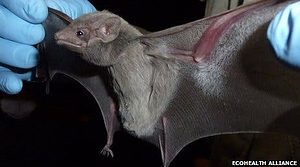Many months later after scientists isolated thousands of samples taken from different bat species found close to the home of the first known victim of the Mers coronavirus – a deadly virus which first emerged in the Middle East last year, killing 47 so far (~50% fatality among infected) – scientists found the evidence of the presence of the virus in one species only: the Egyptian tomb bat.
Dr Ian Lipkin, director of the Center for Infection and Immunity from Columbia University and a co-author of the study, said: “In this case we have a virus in an animal that is identical in sequence to the virus found in the first human case.”

The Mers virus has well proven its potential for being deadly, and naturally scientists have been taking measures not only to contain the virus, but also understand how it works and keep it stable so that it may not evolve into something truly pandemic. We still know little about it – far too little considering the threats it may pose.
The virus can indeed spread from human to human, however it was observed that the likeliest source of infection is of animal origin. Since this claim has been made, scientists have been scouring feverishly on the prowl for the contact zero animal.
This latest lab confirmation hints that the Egyptian tomb bat may be the origin of the plague. It wouldn’t be that surprising considering they are a source of lots of human virus infections, like Ebola, henipahvirus, rabies and Sars. However, in this case, while they may be the original bearers of the virus, bats most likely aren’t the one actively spreading the virus to humans.
“Even if this proves to be the case, bats are unlikely to be the source of the continuing Mers outbreaks. Humans and bats just don’t interact very much. It’s much more likely that an intermediate animal is involved – and finding out what this animal is is key if we are to eradicate this virus before it becomes a bigger problem,” the researchers write.
This intermediate animal is currently sought after, and samples taken from camels, sheep, goats and cattle are now being analysed. Researchers bet their money on the dromedary camel, which was incriminated in an earlier study published in the Lancet Infectious Diseases journal. However, only antibodies – the proteins produced to fight infections – were detected in camels, rather than the virus itself, and more work needs to be done to confirm this finding.
Prof Ian Jones from the University of Reading added: “The surprising overall message is that the bats of (Saudi Arabia) are not awash in the virus, quite the opposite as only one example was found and that appeared to be incomplete.”
“The main reservoir for this virus and how it gets to infect people remains unclear at this stage.”


